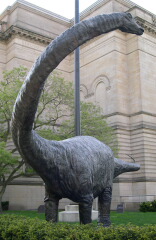Sauropoda
|
|
| Sauropoda | ||||||||||||
|---|---|---|---|---|---|---|---|---|---|---|---|---|
 A statue of Diplodocus carnegiei, taken in Pittsburgh, PA | ||||||||||||
| Scientific classification | ||||||||||||
| ||||||||||||
| Families | ||||||||||||
|
Brachiosauridae |
Sauropoda, the sauropods, are a suborder or infraorder of the saurischian ("lizard-hipped") dinosaurs. They were the largest animals ever to have lived on land. Well-known genera include Apatosaurus (formerly known as the Brontosaurus), Brachiosaurus and Diplodocus.
| Contents |
Description
They were herbivorous (plant-eating), usually long-necked quadrupeds (four-legged), with spatulate (pencil-shaped) teeth. They had long necks, small heads, huge bodies, and tended to have long tails. At least some of them laid eggs, like the camarasaurs and titanosaurs.
But their most defining characteristic is their size. Even the dwarf sauropods (perhaps 5 to 6 meters, or 20 feet long) were counted among the largest animals in their ecosystem. Their only real competitor in terms of size is the Balaenoptera musculus, or blue whale. But unlike the aquatic giant, they were all terrestrial. Some, like the diplodocids, probably held their heads low, while others, like the brachiosaurids, held them high.
Their body design did not vary as much as other dinosaurs, perhaps due to size constraints, but they still displayed ample variety. Some, like the diplodocids, were extremely long, with sails running down the back of their spines, and with tremendously long tails they may have been able to snap to create sonic booms. The Supersaurus, at 40 meters (130 feet), is probably the longest, but Seismosaurus and even the old record holder, the Diplodocus, are still extremely long. Though a possible century-old hoax, the Amphicoelias fragillimus, of which only a drawing of a single vertebra survives, at 55 to 60 meters (180 to 200 feet) would have a spine even longer than the B. musculus. The longest terrestrial animal alive today, the reticulated python, can only reach lengths of up to 10 meters (35 feet).
Others, like the brachiosaurids, were extremely tall, with high shoulders and extremely long necks. The Sauroposeidon is probably the tallest, reaching 18 meters (60 feet) into the air, with the previous record for longest neck being held by the Mamenchisaurus. By comparison the giraffe, the tallest of all living animals, is only 4.8 to 5.5 meters (16 to 18 feet) tall.
And some were just incredibly massive, like the armor-plated titanosaurids. The Argentinosaurus is probably the heaviest at 80 to 100 metric tonnes (90 to 110 tons), though the Paralititan, Andesaurus, Antarctosaurus, and Argyrosaurus are of comparable sizes. And there is some very poor evidence of an even more massive titanosaurid, the Bruhathkayosaurus, which might weigh in at 125 to 170 tonnes (140 to 190 tons). The largest land animal alive today, the Savannah elephant, weighs no more than 10 tonnes (11 tons).
There were even genera with spined backs like the stegosaur (Agustinia) and one with a club-tail (the Shunosaurus), like the Ankylosaurus.
Environment
Sauropods first appeared in the late Triassic, where the early versions resembled the Prosauropoda. By the Late Jurassic (180 million years ago), the diplodocids and brachiosaurids were widespread, but they died out in the Early Cretaceous. The second great wave of sauropods, the titanosaurids, were world-wide by the Late Cretaceous, until all dinosaurs perished, most likely as a result of a bolide impact leading to the Cretaceous-Tertiary extinction event. Fossilized remains have been found on every continent except Antarctica.
Classification
Classification of the sauropods is still very uncertain, especially with the euhelopods, though the cetiosaur, vulcanodont and nemegtosaur families also present many challenges. The titanosaur family has also been very poorly known, though the discovery of a complete skeleton of the Rapetosaurus is changing that.
Recently-discovered short-necked variety
In June 2005, a new type of sauropod was discovered with a short, stubby neck. This new species, Brachytrachelopan mesai, measured less than 33 ft (10 m) long, which is unusually small for a sauropod. Unlike other sauropods, whose necks could get up to four times the length of their backs, Brachytrachelopan's neck was shorter than its backbone. Unable to lift its neck and head above horizontal, this shorter length was likely an adaptation to eating an abundant or nutritious low-growing plant. [1] (http://news.nationalgeographic.com/news/2005/06/0601_050601_stubby_dino.html)de:Sauropoden fr:Sauropoda he:סאורופודה nl:Sauropoda pl:Zauropody pt:Sauropoda sv:Sauropoder
